Kelp forests are stopping points for all manner of life: fish, birds, marine mammals, people. They connect land to water, prey to predators, food chains to food webs. Everything to everything else.
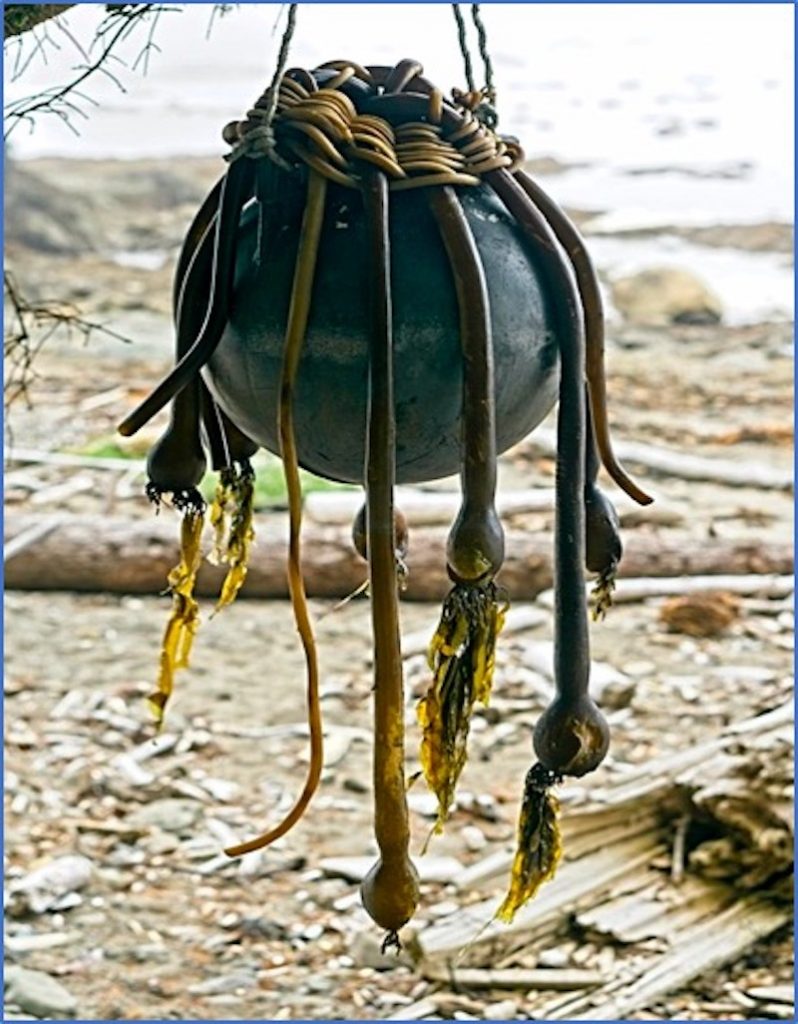
Decades ago, when I was a kid, my family had a summer cabin on a lake in the foothills of the Cascade Mountains in Washington State. We also had a 16-foot runabout with an ancient outboard motor that we used to fish and water ski. But my father grew bored with the lake and wanted a new challenge. He wanted to be nautical, an old salt. So one sunny summer day we manhandled the boat onto its rusty trailer and headed west to the shores of Puget Sound to try out something bigger and saltier.
The trip was ridiculous, given my dad knew nothing about tides, currents, navigation, deadheads (floating logs, not the groupies), or the other things a real old salt would know. And somewhere in the middle of the adventure, we ran into a mass of floating kelp that promptly got wrapped around the propeller, killing the motor. Strong words were uttered as the whole mess was detangled, and we continued on our way. We survived the experience but never again ventured out in salt water. Once was enough for my dad.
In 1980, I began my career as a marine biologist on the same salty waters. Later on, I moved (escaped) the Seattle area and landed on a new shore–the Strait of Juan de Fuca on the Olympic Peninsula–and continued my career. Over the years, I became the old salt my old man wanted to be, and began to learn about and appreciate kelp. Though it still causes me propeller issues from time to time, we mostly get along just fine.
I’ve learned some important lessons about kelp and why it matters, not only to its fellow marine creatures, but also to the ones that live on dry land. Marine scientists call kelp a foundational species, and they are right, as you will see. I’ll start things off with some interesting facts about kelp, talk a little about how human beings have been using it for millennia, discuss the ways kelp helps improve our lives, and look at the lessons it can teach us about being good stewards of both the land and the water. And for good measure, I’ll even throw in something about trophic cascades and zombie sea urchins to keep you interested.
Let’s get started.
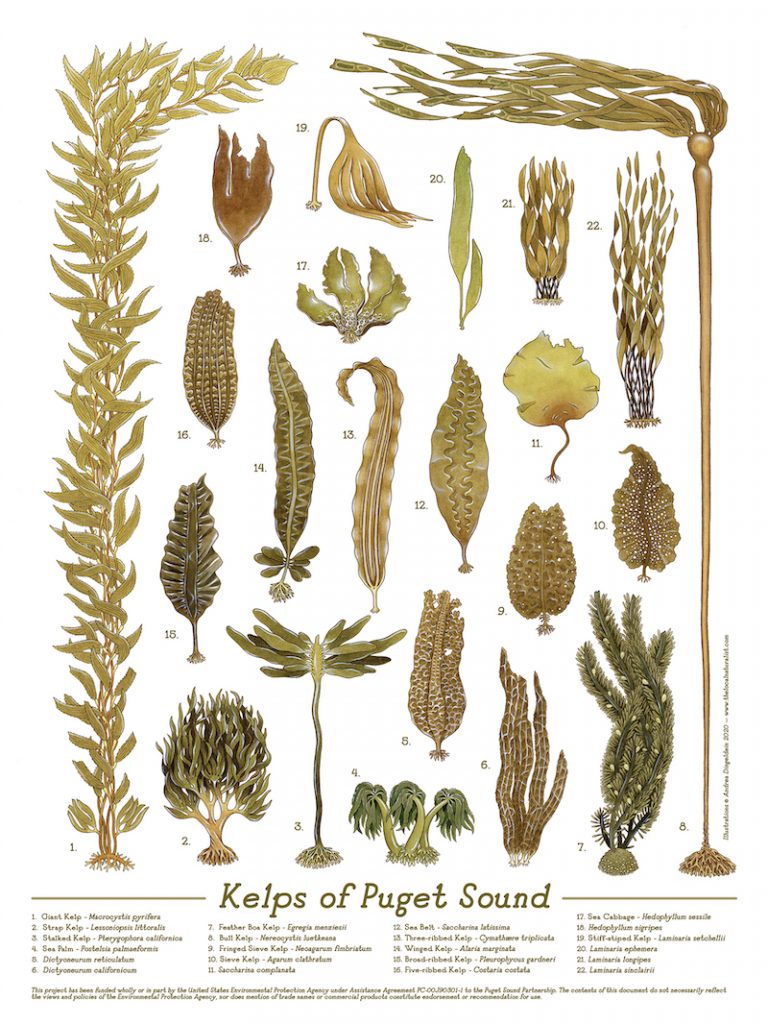
Interesting Things About Kelp
The first thing you notice about kelp is how diverse and beautiful it is. The above illustration was kindly provided to me by Andrea Dingeldein and shows all 22 kelp species found in Washington. Although many of the species in Andrea’s illustration resemble plants, they’re actually classified as brown algae in a class called Phaeophyceae, which means “dusky seaweed” if you speak Greek. As shown in the bull kelp illustration (Number 8), from bottom to top, kelp usually consist of a rootlike holdfast that anchors them to the bottom, a stem-like structure called a stipe, and blades that enable photosynthesis and reproduction. Some species may also have one or several hollow gas-filled floats called pneumatocysts that hold the kelp upright in the water.
Some of the species illustrated above live in relatively shallow water and can be seen if you walk the beach during low tide events. The sea palm, Postelsia (Number 4), for instance, lives in intertidal areas of rocky shores with lots of wave action, like the extreme northwest coast of Washington. As you watch (from a safe distance), it appears to get knocked over by large waves, then pops right back up, shaking off the water, ready for more. One of my personal favorites, the feather boa kelp Egregia (Number 7), is an intertidal species that often gets washed up on the beach by the waves. It looks just like a feather boa fashion accessory popular in the 1800s, the Roaring 20s, and revived again in the 1960s by people like Janis Joplin and Jimi Hendrix. Others, such as giant kelp and bull kelp (the big ones on each side of the illustration), are present in deeper, open water and are the ones that create dense “kelp forests” that provide food and shelter for a variety of fish and invertebrates, are really good at snagging boat propellers, and were not worn by Janis or Jimi.
Although we will focus primarily on the bigger kelp in this article, all kelp species are an incredibly important part of the marine food web that supports everything from smallest microscopic life forms to the blue whale, the largest animals on the planet. In marine water worlds, kelp matters a lot, and it turns out they are important to land dwellers, too. For instance, the kelp that washes up on the beaches in the fall provides food for shorebirds, terrestrial birds and mammals.
And finally, if you’re not already impressed, consider that kelp are one of the fastest growing organisms on Earth, able to grow over 18 inches a day, and some species can grow to a length of 150 feet–much longer than our blue whale friends. And as cool as blue whales are, they can’t photosynthesize, serve as nursery areas for a host of invertebrates and fish, absorb carbon from seawater to reduce the effects of ocean acidification related to climate change, and buffer wave action during storm events. Plus, you can find kelp of one kind or another along the cold or temperate coastlines of North America, South America, northern Europe, Australia, and Asia. Quite a resume for a plant that isn’t even a plant.
Even the naturalist Charles Darwin was impressed:
June 1, 1834. The number of living creatures of all Orders, whose existence intimately depends on the kelp, is wonderful. On shaking the great entangled roots, a pile of small fish, shells, cuttlefish, crabs of all orders, sea-eggs, star-fish, beautiful crawling animals of a multitude of forms, all fall out together. I can only compare these great aquatic forests with the ones in the intertropical regions. Yet if in any country a forest was destroyed, I do not believe nearly so many species of animals would perish as would from here, from the destruction of the kelp. (Charles Darwin, Voyage of the Beagle).
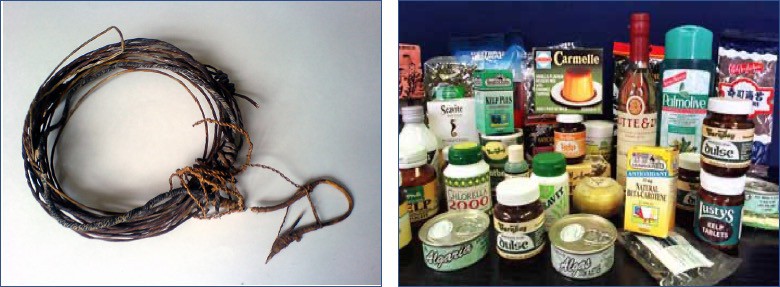
Right Image: Consumer products that include kelp.
Historical and Current Uses of Kelp
Kelp and humans have a long history, beginning at least 4,700 years ago based on Chinese written records. A document from around 600 BC suggests the Chinese held it in high regard:
“Some algae are a delicacy fit for the most honorable guest, even for the king”
First Nations and Native Americans along the west coast of North America integrated kelp extensively into their cultures, and some archaeologists believe that the first settlers to North and South America may have followed marine resources (including kelp) along the “Kelp Highway” from Japan east and south all the way to Chile at the tip of South America. Kelp was used by coastal tribes for food, to make stout line for fishing (as shown in the above image), as medicine, to preserve food, and as a trading commodity with inland tribes. Bull kelp, in particular was considered the most valuable marine plant for coastal tribes, serving as food containers, a key component in the process of bending and shaping wooden utensils and hooks, and even as kitchen utensils. It was general knowledge that many fish and invertebrates would be found near kelp forests, and the Makah tribe of the northwest coast often used kelp beds as overnight resting areas during long canoe trips.
Although traditional uses of kelp continue to the present day, the uses of kelp have expanded and evolved in modern societies in astounding ways. Marine algae are used as sources of or additives to food, cosmetics, pharmaceuticals, and fertilizers, and are important economic and cultural components in Asian societies and traditions. Kelp usage is also increasing in western countries, where extraction of kelp to obtain phycocolloids and some biochemicals is gaining momentum. Have you heard of alginate? If you’re a dentist, you’re certainly familiar with its characteristics. Alginate is found in the cells of brown kelp and is used in the dental industry to create exact impressions of jaw, teeth, and mouth structures. Kelp and other marine algae are also being studied as new sources of biofuels, and are being actively “farmed” in nearshore aquaculture facilities in Maine.
Trophic Cascades and Zombie Urchins
You often hear scientists talk about “food chains” or “food webs.” The terms are a bit confusing, but the actual concepts are pretty straightforward: a food chain describes who is eating whom, and a food web is a collection of food chains in an ecosystem. In practice, the things that go on in an ecosystem like a kelp forest are complex and ever-changing. They can be influenced by a variety of things beyond predator/prey relationships, including long- and short-term environmental changes, disease, the presence of invasive species, and the activities of humans (anthropogenic influences). As you can imagine, because of all the connectivity, a dramatic change in a food chain or collection of food chains can have a profound effect on an ecosystem, but they may initially be hard to detect because of all the variability present within the system.
Terrestrial and marine scientists spend a lot of time studying food chains and food webs in an attempt to detect significant changes, understand their complexities, identify their driving forces, and determine their overall resilience to natural or anthropogenic stressors. Sometimes the disruptions to specific food chains become so large and obvious, it’s hard NOT to notice it. The disruptions are called “trophic cascades,” and a big one is currently occurring in coastal California, where the interactions of kelp forests, sea urchins, and sea urchin predators are drastically reducing or eliminating kelp forests from nearshore areas.

The upper part of the illustration above shows what a balanced system should look like: sea urchins are scrounging around on the ocean bottom, eating kelp holdfasts that anchor the algae to hard substrate, but their numbers are limited by the presence of predators, in this case, large starfish. Life is good for everybody except, of course, the consumed urchins.
The lower part of the illustration shows what’s going on in California. As reported in the New York Times, a “perfect storm of bad things” began happening to kelp when a major aquatic heat wave driven by El Niño occurred from 2014 to 2016. At nearly the same time, the population of sunflower starfish was decimated by starfish wasting disease, removing the main predator to the urchins. Surveys of the impacted areas in 2015 found the seafloor carpeted with urchins and no kelp forest for 400 miles of coastline from Marin County to the Oregon border. What was left was characterized as an “urchin barren” composed of “zombie urchins.” When urchins run out of food, they revert to a shrunken, zombie-like state that may persist for decades. (I’m not making this up!)
What to do? We could let nature deal with it, and maybe the system would eventually stabilize and the kelp would return. But it may take decades, or it may never recover. And as we now know, the loss of a kelp forest means the loss of an entire connected ecosystem: no nursery areas for fish and invertebrates, no habitat for birds and marine mammals, no carbon sequestration, no shoreline protection, and no food products for humans. Another option that is being considered is to relocate sea otters to affected areas to feed on the urchins. But sea otters apparently don’t like the taste of zombie urchins, and moving them around is problematic.
Recent information posted by Bay Nature suggests that at least in some areas, kelp appears to be surging back without human intervention, though the barrens are still present through much of northern California. Keep an eye on this particular trophic cascade; it may be a harbinger of things to come in our rapidly changing world, or an event that makes us reconsider what we think we know about environmental stability.
Monitoring and Conservation
There’s an old adage that we protect what we love. So if you’re starting to love kelp, the first step in protecting and restoring it is to figure out what kind of shape it’s in and what stresses it out. That knowledge can then become a story, and the story can help change minds and create opportunities for investing time and money in protection and conservation. Thankfully, where I live, there is a lot going on with regard to monitoring and conservation.
Kelp monitoring can be a challenge, given the wide distribution of kelp in the marine waters of the west coast, hazards associated with wind, waves, and tides that can complicate field studies, and the short timeframe for observing it during its peak growing season in the late spring and summer when it is most visible. Small boats, kayaks, fixed-wing aircraft, and even satellites have been used to map kelp beds in coastal locations. The Washington State Department of Natural Resources has done some great work using fixed-wing aircraft with sophisticated cameras to create maps of kelp abundance from year to year. They also use small boats in protected areas to augment the aerial data. This work has identified areas like southern Puget Sound, where significant losses of kelp forests have occurred. The Northwest Straits Commission and its partner Marine Resources Committees (MRCs) have also become involved in kelp monitoring. Each summer, many MRC volunteers use sea kayaks equipped with global positioning system (GPS) devices to paddle around the perimeter of local kelp beds to assess total acreage and compare results from year to year. An example of their work is presented below.
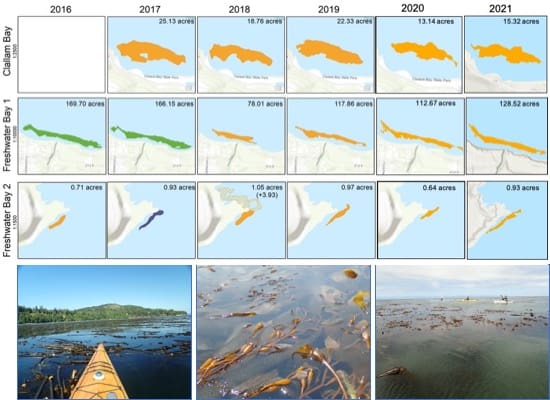
The graphic above shows how the kelp forest “footprint” has changed a bit over time at Freshwater Bay and Clallam Bay west of Port Angeles, Washington. The good news is that those beds have remained relatively stable, probably because they benefit from cooler, nutrient-rich Pacific Ocean water and the lack of stressors from intense nearshore development that exists near larger cities and urban areas.
The information these groups have gathered is helping us better understand kelp dynamics in Puget Sound and the Salish Sea, the status of local and regional kelp forests, and the important role kelp plays in the ecology of our region. We don’t know the whole story of what’s behind the kelp losses or why some places are doing better than others, but we’re learning, and the story is becoming clearer. The monitoring work resulted in a greater awareness of kelp resources at risk, which led to the development of the Puget Sound Kelp Conservation and Recovery Plan by the Northwest Straits Commission in collaboration with federal, state, and local partners. Organizations like the Puget Sound Restoration Fund are looking at ways to reverse bull kelp declines in Puget Sound and are doing some great science that will benefit everyone.
Why Kelp Matters: A Connected World
As I come to the end of this article, I’m struck by the way kelp and kelp forests serve as a connection between the things of the sea and the things of the land. The kelp forests are stopping points for all manner of life: fish, birds, marine mammals, people. They connect land to water, prey to predators, food chains to food webs. Everything to everything else.
Big waves spawned by winter storms lose some of their energy in kelp forests on their way to land; kelp forests thus protect the people and things living on the shore from greater harm.
The iconic killer whales of the Northwest eat adult salmon that left their natal streams as juveniles and hid from larger predators in eelgrass and kelp forests until they were big and strong enough to begin their life journey–a journey that ultimately ends far inland where they spawn and die, leaving their bodies to the creatures of the land.
If our kelp forests die, the loss would be greater than that of a terrestrial forest meeting the same fate (if you agree with Charles Darwin). When a foundational species is lost, everything that depended on it must adapt, find a new home elsewhere, or disappear. In California, the urchin barrens that replaced the kelp forests are exactly that: a barren landscape, a dead zone. They provide little to no nursery habitat for marine life, no carbon sequestration, no protection from storms, and no vibrant, resilient habitats teeming with life. And there is no way to know if or when the kelp will return. I suppose we can live with that reality, but is it truly the one that we would choose?
Perhaps the best writing on “connectedness” I know of comes from the author, John Steinbeck. The theme is present in nearly all of his work, from the Grapes of Wrath to the Log from the Sea of Cortez. In the early spring of 1940, Steinbeck and his best friend, the marine biologist, Ed Ricketts, chartered a boat to explore the intertidal life in the “Sea of Cortez,” now known as the Gulf of California, that narrow bit of water that separates the Baja Peninsula from the Mexican mainland. During their voyage, and thousands of miles away, World War II was raging, and both men tried to keep up with the news as they traveled along. It is not completely clear who wrote the short paragraph below, but it was probably the collaborative effort of two good friends who saw the whole of life in a tidepool and recognized its importance:
“…Let us go,” we said, “into the Sea of Cortez, realizing that we become forever a part of it; that our rubber boots slogging through a flat of eel-grass, that the rocks we turn over in a tide pool, make us truly and permanently a factor in the ecology of the region. We shall take something away from it, but we shall leave something too.” And if we seem a small factor in a huge pattern, nevertheless it is of relative importance. We take a tiny colony of soft corals from a rock in a little water world. And that isn’t terribly important to the tide pool. Fifty miles away the Japanese shrimp boats are dredging with overlapping scoops, bringing up tons of shrimps, rapidly destroying the species so that it may never come back, and with the species destroying the ecological balance of the whole region. That isn’t very important in the world. And thousands of miles away the great bombs are falling and the stars are not moved thereby. None of it is important or all of it is.”
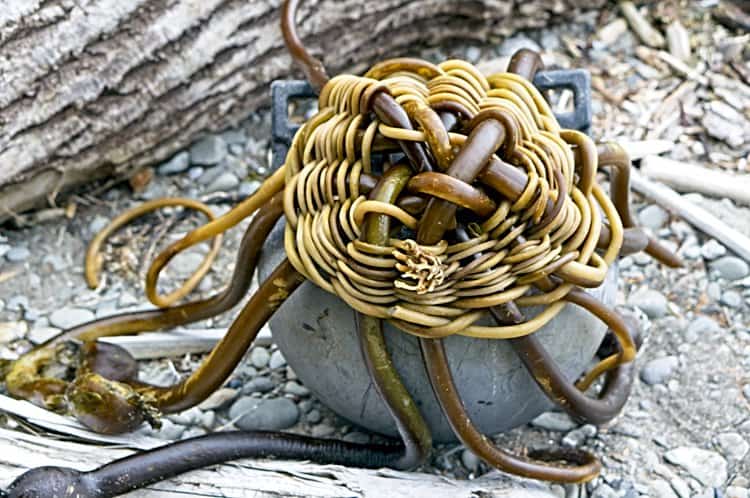
Dedicated to my friend Caroline Gibson
Information Sources
Interesting Things About Kelp
Kelps of Puget Sound, Andrea Dingeldein, http://www.thelocalnaturalist.com
Kelp Forest, Oceana.com. https://oceana.org/marine-life/marine-science-and-ecosystems/kelp-forest
Global Distribution of Kelp, ResearchGate, https://www.researchgate.net/figure/Global-distribution-of-kelp_fig4_313161375
Kelp Forest Zooplankton, Forage Fishes, and Juvenile Salmonids of the Northeast Pacific Nearshore, J. Shaffer, S. Munsch, J. Cordell, Marine and Coastal Fisheries: Dynamics, Management, and Ecosystem Science 12:4–20, 2020, https://afspubs.onlinelibrary.wiley.com/doi/pdf/10.1002/mcf2.10103
Historical and Current Uses
The Potential Use of Seaweeds and Marine Plants by Native Peoples of Alta and Baja California: Implications for “Marginal” Island Ecosystems: Implications for “Marginal” Island Ecosystems, Amira Ainis et al., DOI: 10.5744/florida/9780813056166.003.0005, February 2019, https://www.researchgate.net/publication/335919224
APPENDIX B: The Cultural Importance of Kelp for Pacific Northwest Tribes, Nicole Naar, NOAA National Marine Fisheries Service, Puget Sound Kelp Conservation and Recovery Plan, https://nwstraits.org/media/2925/appendix_b_the-cultural-importance-of-kelp-for-pacific-northwest-tribes.pdf
Knowing Home: Braiding Indigenous Science With Western Science, Book 2, Chapter 7 – Cross-Cultural Marine Science: Culturally Inclusive Curriculum for All Learners, David Ashurst; Richard Kool; and Gloria Snively. https://pressbooks.bccampus.ca/knowinghome2/chapter/chapter-7/
Uses of Seaweeds: Present and Future, The Seaweed Site: information on marine algae, https://www.seaweed.ie/uses_general/usesdiagram.php
What is Alginate?, Dalchem Moulding and Casting Supplies, https://dalchem.com.au/how-to/what-is-alginate.
Scientists Hope To Farm The Biofuel Of The Future In The Pacific Ocean, Ari Shapiro, National Public Radio, August 22, 2017, https://www.npr.org/sections/thesalt/2017/08/22/542903378/scientists-hope-to-farm-the-biofuel-of-the-future-in-the-pacific-ocean
An Ecosystem Approach to Kelp Aquaculture in the Americas and Europe, Gretchen Grebe et al., Aquaculture Reports, Volume 15, November 2019, Science Direct, https://www.sciencedirect.com/science/article/pii/S2352513419300134
Trophic Cascades and Zombie Urchins
What Is a Trophic Cascade? Definition and Ecological Impact, Lisa Jo Rudy, Treehugger, February 12, 2021, https://www.treehugger.com/trophic-cascade-5112470.
Apex predators and trophic cascades in large marine ecosystems: Learning from serendipity, Robert Steneck, Proceedings of the Natural Academy of Sciences of the United States of America, May 22, 2012, https://www.pnas.org/content/109/21/7953.
Zombie’ Urchins Are Destroying Kelp Forests. Can’t We Just Eat Them?, Laura Smith, The New York Times, October 4, 2021, https://www.nytimes.com/2021/10/04/dining/california-sea-urchin-kelp-coastline.html.
Emergency Sea Otters Needed to Save California’s Kelp Forests, Kristen Houser, Freethink, August 21, 2021, https://www.freethink.com/environment/kelp-forests.
Opinion: What is a Trophic Cascade?, Ripple et al., Trends in Ecology & Evolution, Vol 31, No.11, November 2016. http://trophiccascades.forestry.oregonstate.edu/sites/trophic/files/Ripple%20et%20al%20What%20is%20a%20TC.pdf
How Kelp Forests off California Are Responding to An Urchin Takeover, Anushree Dave, March 29, 2021, Science News, https://www.sciencenews.org/article/how-kelp-forests-california-urchin-takeover-sea-otter
Kelp Forests Surge Back on Parts of the North Coast, with a Lesson About Environmental Stability, Alastair Bland, Bay Nature, September 13, 2021, https://baynature.org/2021/09/13/kelp-forests-surge-back-on-the-north-coast-with-a-lesson-about-stable-environments/
Conservation and Monitoring
Clallam Marine Resources Committee, Kelp Monitoring, https://www.clallamcountymrc.org/projects/
Kelp Monitoring, Washington State Department of Natural Resources, https://www.dnr.wa.gov/programs-and-services/aquatics/aquatic-science/kelp-monitoring
Finding Floating Forests: It Takes an Online Village to Map Massive Kelp, NASA Earth Observatory, https://earthobservatory.nasa.gov/features/FloatingForests
Puget Sound is Losing its Kelp, but There’s a Plan to Save it, Making Waves – Stories From the People Protecting and Recovering Puget Sound, November 9, 2020, https://makingwaves.psp.wa.gov/index.php/2020/11/09/puget-sound-is-losing-its-kelp-but-theres-a-plan-to-save-it/
Puget Sound Kelp Conservation and Recovery Plan, Northwest Straits Commission, NOAA National Marine Fisheries Service, Puget Sound Restoration Fund, Washington Department of Natural Resources, and Marine Agronomics, January 2020,
https://www.nwstraits.org/media/2880/pugetsoundkelpconservationandrecoveryplan_public_review_draft_1219.pdf Bull Kelp Restoration, Puget Sound Restoration Fund, https://restorationfund.org/programs/bullkelp/
Why Kelp Matters: A Connected World
The Log from the Sea of Cortez, John Steinbeck and Ed Ricketts, https://en.wikipedia.org/wiki/The_Log_from_the_Sea_of_Cortez
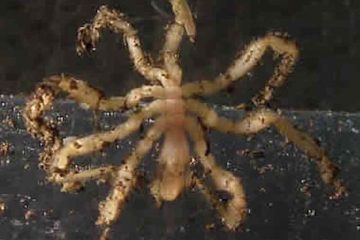
0 Comments